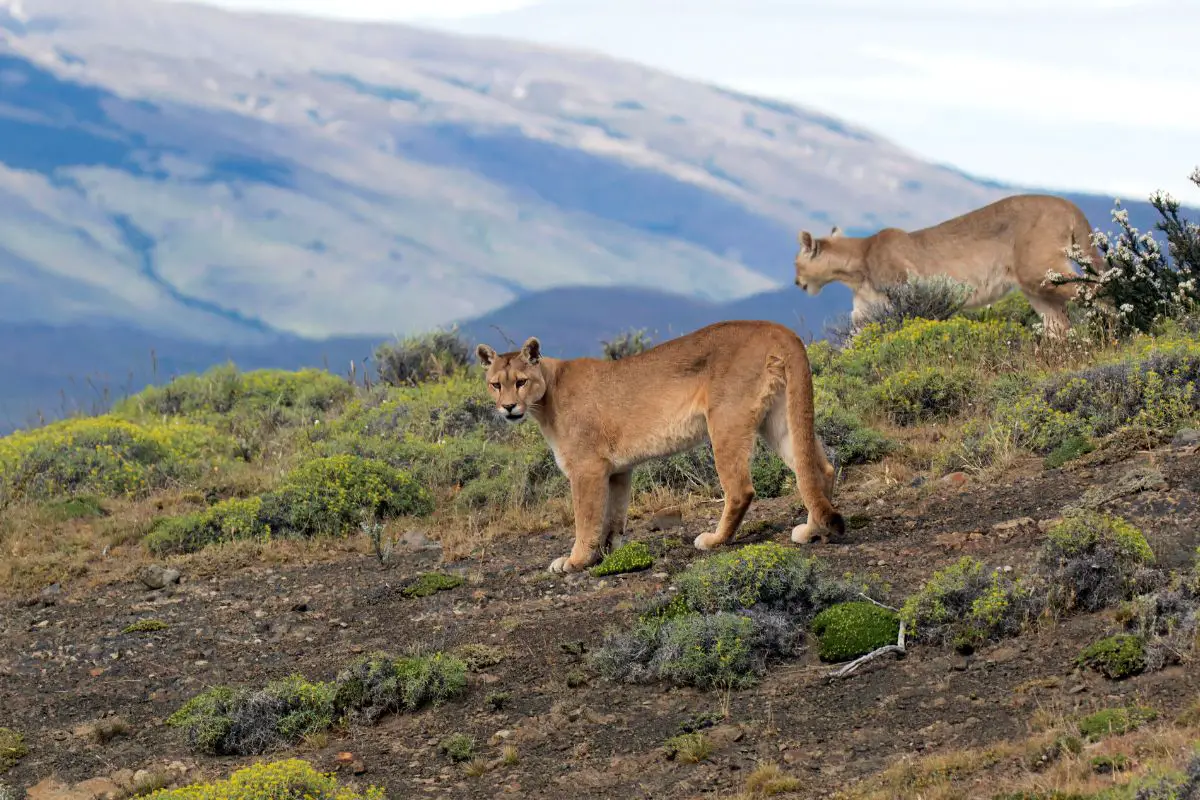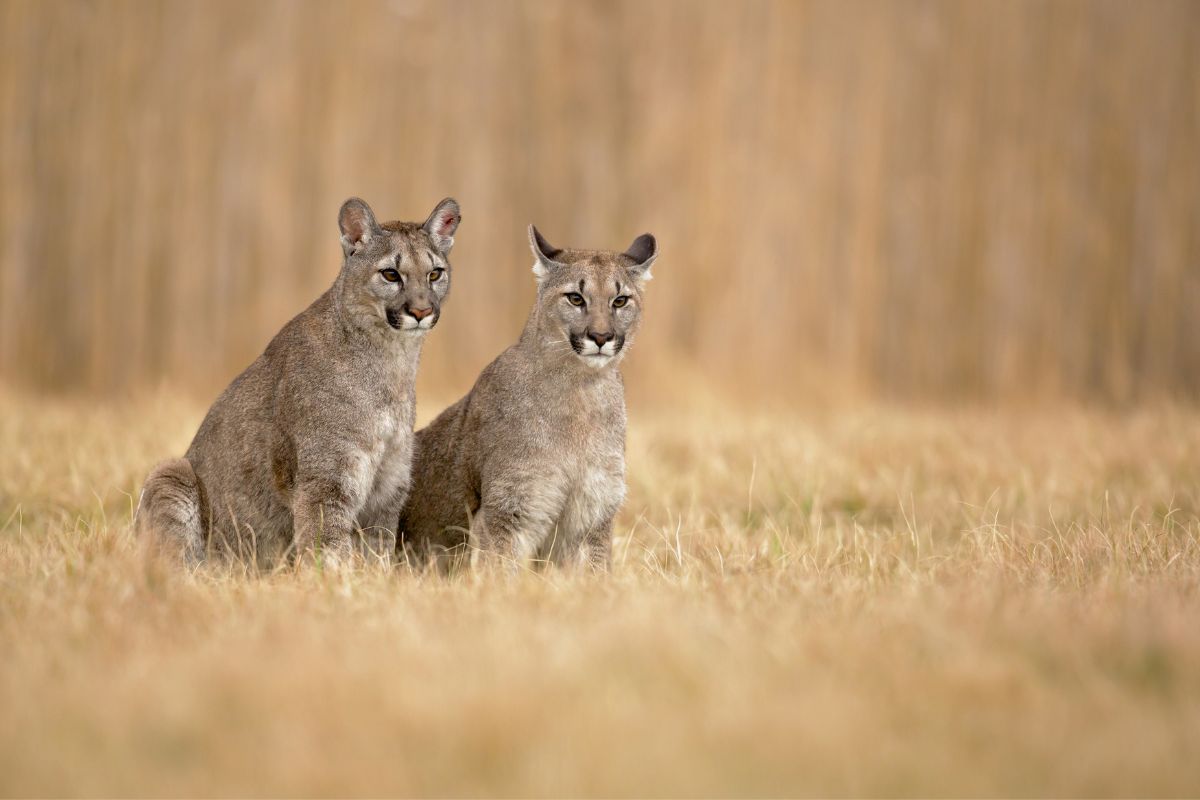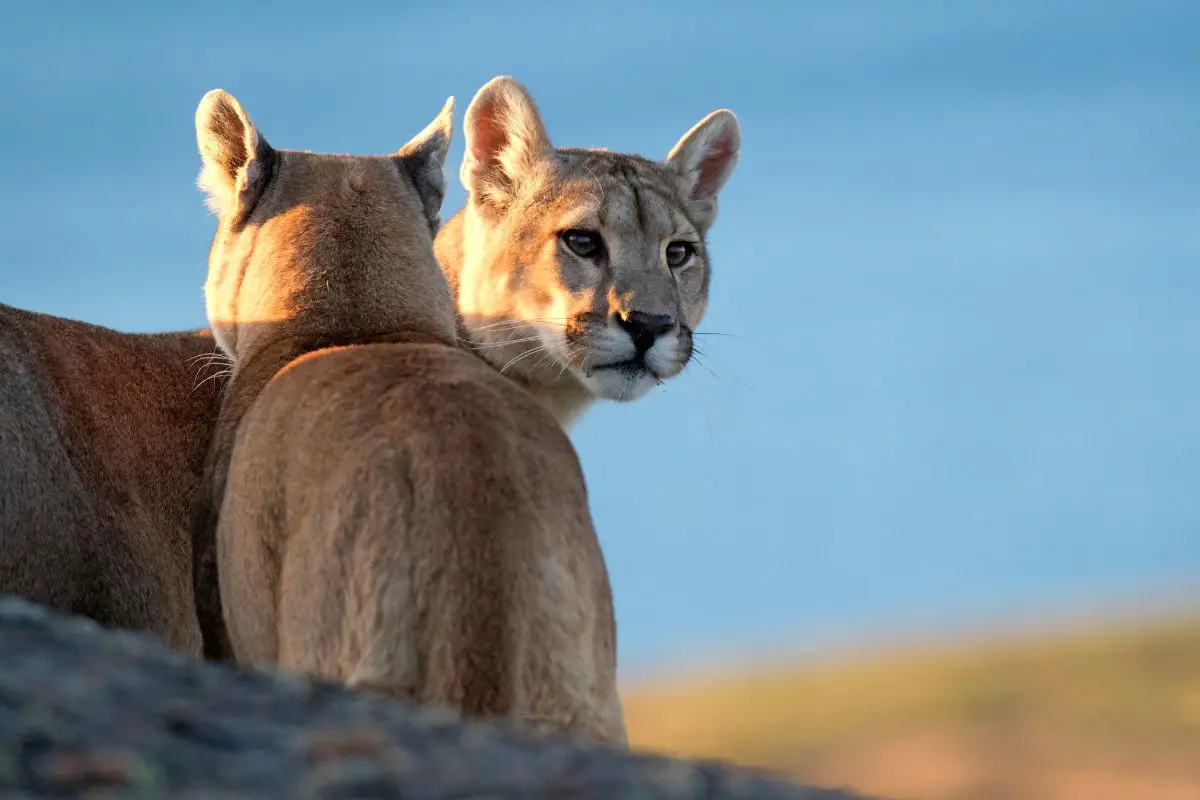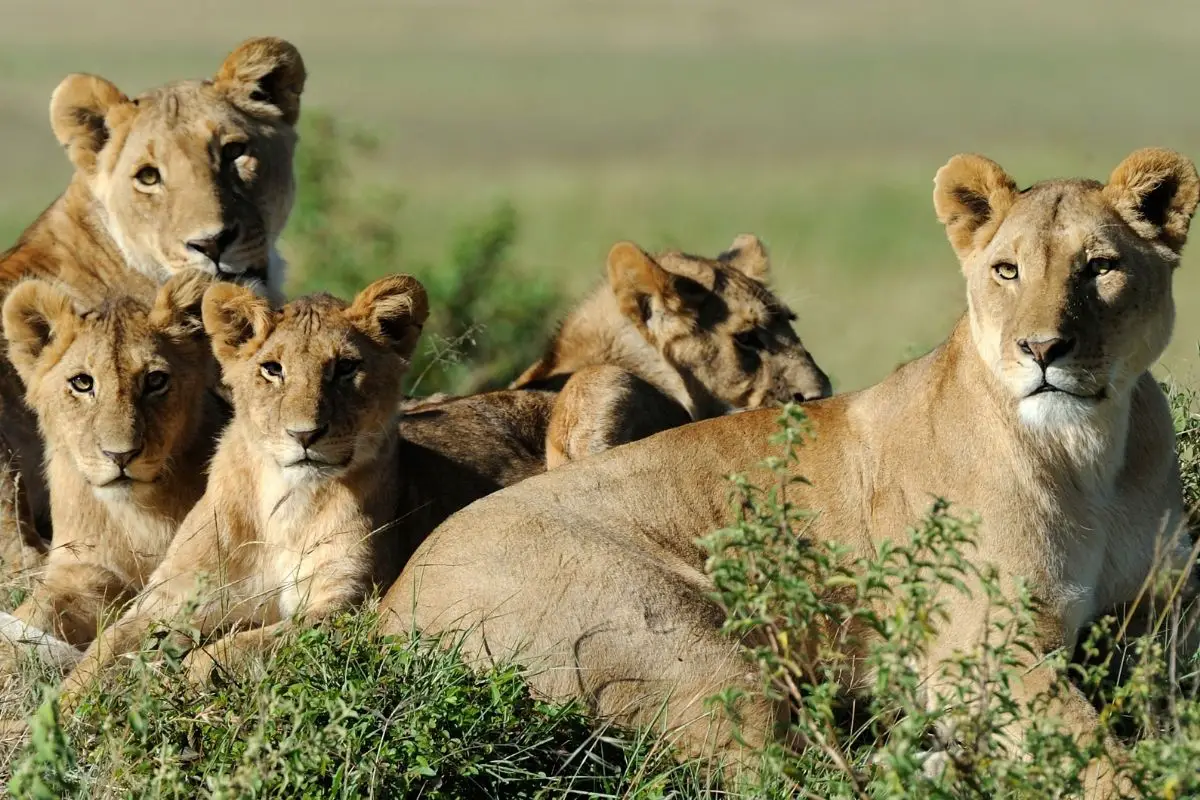Mountain lions go by many names – cougar, puma, catamount, and so many more.
They even hold the world record for having the most English names for a single species! No matter what you call this beautiful cat, the mountain lion is a formidable predator.
These animals can be found in North, South and Central America in varying populations.

Their numbers are followed closely in countries like the United States, but less is known about them in South and Central America.
There are thought to only be approximately 50,000 mountain lions left in the world.
This number has dropped significantly in the last century or two, thanks to extensive hunting. If you want to learn more about the distribution of cougars left in the world, keep reading.
We will be going through everything you need to know.
Where Do Mountain Lions Live?
Habitat
Mountain lions cover a huge range – all the way from Alaska to Argentina and southern Chile.
As a result, they are known to thrive in a wide range of ecosystems, so long as there is enough shelter and prey for the animals to live on.
Because of their immense range, cougars can be seen in a number of habitats. These include wetlands and forests to deserts and mountains.
No matter where they are, however, pumas prefer to stay away from humans and away from too much development.
There have been instances, however, where mountain lions are seen close to cities, or in city suburbs.
The majority of mountain lions in the United States are found in desert or dry habitats, as is the usual in states like California.
They are also in forested areas in states like Washington, and wetland areas like in southern Florida.
In South America, many mountain lions can be found in mountainous areas, as their name suggests.
These South American subspecies also do well in valleys and gorges, swamps, marshes, and thick broadleaf forests.
Range And Distribution
Mountain lions are present in southern Canada all the way to southern Chile and Argentina.
In the United States, they are only known to have breeding populations in the western states, as well as Florida.
Although they are present in a number of South American countries, too, tracking their distribution is incredibly difficult.
The number of animals in South American countries is unknown, and few countries have been able to track mountain lions in their borders.
However, according to accounts provided by a number of counties in South America, the puma is present in many of them.
Like many states, however, this animal has also become extinct in some countries, and is thought to have remained so.
More information and research is needed before we can get a full picture of the situation, though.
Over the years, mountain lions have had to give closer and closer to humans and their towns and cities.
While alarming, it is important to remember that we as humans are the ones who have been gradually reducing their natural areas.
For example, cougars are primarily native to the West in the United States.
States like California, Washington, and Nevada are relatively well built-up, which has encroached on the mountain lion’s natural habitats.
This destruction of habitat means that we are living in mountain lion territory, and coming across them occasionally is expected.
It is also important to note that the historical distribution of mountain lions used to be far wider than it is today.
These animals used to be found throughout the United States, including the East coast and along the US-Canadian border.
We will be covering this in a separate section below.
Once again, wherever there is prey and shelter for these animals, they are likely to do well.
This may be becoming more true now than ever, too, as mountain lions are being spotted in states where they were previously made extinct.
These states include a number on the East Coast, so there is the possibility of these animals returning to their old habitats, where there is plenty of prey for them to thrive.
Historic Distribution

Mountain lions used to be present across the United States, and various parts of Canada.
However, primarily due to colonizers and the growing population, they have become extinct in many eastern states.
These animals used to thrive in states such as New York, Maine, and Maryland. Since the 1800s, populations have dropped, leading to their extinction in many of them.
This hunting has even led to the extinction of a subspecies of puma – the Eastern puma.
Similarly, overhunting in Central and South America has led to cougar populations disappearing in some countries.
Thankfully, however, populations are thought to be relatively healthy in many of these countries thanks to the rich habitats available to the animals.
Mountain Lion Populations
In North America
Canada
- Between 5,500-9,000
Thanks to the rich wildlife and habitat, there is a healthy population of pumas in southern Canada.
These numbers are not as high as they have been, but the population seems to be going well in the areas where they have remained.
United States
- Alabama – no known breeding population
- Alaska – no known breeding population
- Arizona – up to 2,700 animals
- Arkansas – 20-30 animals
- California – up to 6,000 animals
- Colorado – up to 7,000 animals
- Connecticut – no known breeding population (unconfirmed sightings becoming increasingly common)
- Delaware – no known breeding population (unconfirmed sightings)
- Florida – possibly 120-230 animals
- Georgia – 3 confirmed sightings
- Hawaii – no known breeding population
- Idaho – 2,000 animals
- Illinois – no known breeding population (confirmed sightings)
- Indiana – no known breeding population
- Iowa – 6 confirmed sightings
- Kansas – no known breeding population (36 sightings)
- Kentucky – no known breeding population
- Louisiana – no known breeding population (rare sightings)
- Maine – no known breeding population
- Maryland – possibly 100 animals
- Massachusetts – no known breeding population (two unconfirmed sightings)
- Michigan – possibly 74 animals
- Minnesota – no known breeding population
- Mississippi – no known breeding population
- Missouri – no known breeding population
- Montana – up to 5,700 animals
- Nebraska – possibly 34 animals
- Nevada – up to 2,200 animals
- New Hampshire – no known breeding population
- New Jersey – no known breeding population
- New Mexico – up to 4,300 animals
- New York – no known breeding population
- North Carolina – no known breeding population
- North Dakota – possibly 80 animals
- Ohio – no known breeding population
- Oklahoma – no known breeding population (11 confirmed sightings)
- Oregon – up to 7,600 animals
- Pennsylvania – no known breeding population
- Rhode Island – no known breeding population
- South Carolina – no known breeding population (no confirmed sightings)
- South Dakota – up to 532 animals
- Tennessee – no known breeding population (few confirmed sightings)
- Texas – 170-454 confirmed sightings
- Utah – up to 4,000 animals
- Vermont – no known breeding population
- Virginia – no known breeding population
- Washington – up to 1,500 animals
- West Virginia – no known breeding population
- Wisconsin – possibly 76 animals
- Wyoming – up to 2,000 animals
Arizona
The mountainous areas of Arizona have healthy puma populations of up to 2,700 animals.
According to the research, mountain lion populations are stable and even growing, and while hunting is legal, it is very closely regulated.
Arkansas
Mountain lions were rare in Arkansas after 1920, but numbers seem to be increasing as more sightings are confirmed every year.
Though the population is only estimated to be between 20-30, the presence of feral hogs could be a huge pulling factor for them.
California
California has a huge area of habitat that’s perfect for mountain lions, and they have a large population of these animals.
With the population being protected, there are estimated to be between 4,000 and 6,000 pumas in the mountains and foothills of this state.
Colorado
With potentially the highest puma population in the US, Colorado may have an impressive 7,000 animals within its borders, according to research.
The landscape and other wildlife make this state perfect for cougar populations.
Florida

This state is known to be home to the Florida panther – a puma subspecies. This subspecies exists in small populations between 120-230.
Georgia
There have only been three credible puma sightings in the last 25 years.
Idaho
There are thought to be around 2,000 pumas in Idaho. They are legal to hunt in the state, but strict guidelines are in place.
Iowa
There have only been 6 confirmed sightings of pumas in Iowa, but there is not believed to be a breeding population in the state.
It’s more likely that there are animals that pass through the state rather than staying there.
Maryland
The official cougar count in Maryland is not known. However, there could be up to 100 animals that roam the state and pass through it.
Michigan
There is no longer an established population of pumas in Michigan.
However, there could possibly be up to 74 animals that are in, or travel through the state, according to sightings.
Montana
Montana has a healthy population of cougars, with an estimation between 4,000-4,500 animals.
They were classified as a “game animal” in the early 1970s, which led to their hunting being controlled. This allowed them to recover their numbers.
Nebraska
There are only estimated to be around 34 cougars in Nebraska, due to sightings, but no new estimations or research has been done.
Nevada
Although estimates fluctuate, it is thought that there is a healthy population of around 2,000 pumas in Nevada.
They primarily live in the mountains and forests, where there is plenty of game.
New Mexico
Recent research has stated that there are likely around 4,300 mountain animals within the state borders.
North Dakota
The number of sightings in North Dakota vary, with some reports stating there could be between 20-80 animals in the state.
More research is needed to get an accurate number.
Oregon
With an estimated population of around 6,000 cougars in Oregon, they thrive in this state thanks to the habitat.
South Dakota
Mostly in the Black Hills region, there are thought to be between 300-500 in the state.
Texas
Texas has the potential to support over 6,000 cougars, but there are only between 170-454 of these animals in the state.
Utah
There are between 2,500-4,000 pumas in Utah, and the number of animals that can be hunted annually is strictly controlled.
Washington
There are thought to be around 1,500 cougars throughout the state of Washington.
Wisconsin
Although there’s no permanent breeding population here, there have been numerous sightings of cougars over the years.
Wyoming
There are thought to be around 2,000 cougars in Wyoming, thanks to the abundance of wildlife in the state.
In Central And South America
Except for the numbers given below, there is little information regarding the population of cougars throughout Central and South America.
- Argentina – population unknown
- Belize – between 800-1,000 animals (sources may differ)
- Bolivia – population unknown
- Chile – population is unknown
- Colombia – population is unknown
- Costa Rica – population is unknown
- Ecuador – population is unknown
- Guatemala – population is unknown
- Honduras – population is unknown
- Nicaragua – 218 currently being tracked
- Panama – population is unknown
- Peru – population is unknown
- Venezuela – population is unknown
Final Thoughts
There are estimated to be only 50,000 cougars in the world.
Their prime hotspots are in states like California and Colorado, but their sightings have been reported further east than before.
This could mean that the beloved mountain lion could be making a comeback in a number of states in the east where they once used to roam freely before being killed off.
- Bengal Cat vs Wild Bengal Tiger: Complete Comparison 2025 - October 31, 2025
- Complete Wild Cat Spotting Guide for Hikers 2025 - October 31, 2025
- Lynx vs Bobcat: Complete Field Identification Guide 2025 - October 30, 2025








